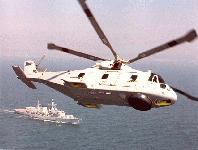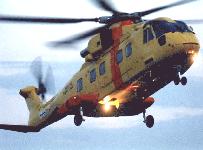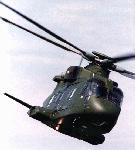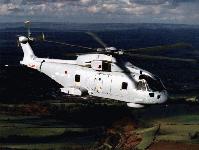FAS |
Military |
DOD 101 |
Systems |
Aircraft |
ROW ||||
Index |
Search |
Join FAS




EH101 Merlin
EH101 Cormorant
The EH101, developed jointly by Agusta of Italy and GKN Westland Helicopters, combines military and civil variants in a single integrated program with an optional rear loading ramp and full ice protection system. The EH101 is now in full production in both Italy and the United Kingdom with launch orders for over 80 aircraft. The EH101 is the only new medium lift helicopter that is in full production and available in four variants. The Integrated Development Programme (IDP) under which the EH101 was developed was an Anglo-Italian collaborative program. Each nation is currently procuring variants of the baseline helicopter. Maritime patrol variants of the aircraft have been ordered by the British Royal Navy and by the Italian Marina Militare Italiana (MMI). The MMI has also ordered the utility transport and enhanced air and surface surveillance variants and the British Royal Air Force has contracted for 22 EH101 SH (support helicopter)
military utility aircraft.
Merlin HM MK1 (formerly Merlin EH101) is an Anti-Submarine (ASW) variant of the EH101 helicopter. It entered service in December 1998, replacing the ageing ASW Sea King (Mk6). The collaborative program began in 1979 through EH Industries - the company formed by Agusta of Italy and GKN Westland in the UK. Designed in Western Europe, it is the largest collaborative helicopter project in history and the most powerful helicopter in terms of military capability. The mission system is world-leading and the weapons system is a significant force multiplier compared with existing capability.
In 1991 the United Kingdom selected IBM-Aerospace Systems Integration Corporation (ASIC) (subsequently Loral-ASIC, now Lockheed Martin ASIC (LMA)) as prime contractor to complete Royal Navy development, integration of the Mission System and production of 44 aircraft. Since then progress has been made on the programme through the award of the Collaborative Production Investment contract in March 1992 to EH Industries. Awards were also made to Lockheed Martin ASIC for the Merlin Training System in July 1994, and the MERLIN Support and Spares Availability System (MSSAS) in July 1996.
Progress on the project has been hampered by accidents on the collaborative program to three prototype aircraft in 1993, 1995 and 1996. However, the first flight by a production MERLIN was on 6 December 1995 and the first mission system fitted Merlin flew in January 1997. Royal Navy Intensive Flight Trials began on schedule in December 1998.
The aircraft has a state-of-the-art, integrated mission system, which processes data from an extensive array of on-board sensors, giving Merlin an independent capability to search for, locate and attack submarine targets. It is this autonomous capability which makes Merlin unique among ASW helicopters. The aircraft and its mission system are managed by two computer systems, linked by dual data buses. The cockpit is designed for operation by a single pilot, with the auto-pilot allowing for hands-off flight for most of the mission.
Normally flown by a crew of three - pilot, observer and aircrewman - Merlin is equipped with the Thomson-Marconi active "dunking" sonar which gives enhanced submarine detection ranges, and the GEC Marconi AQS 903 acoustic processor. All crew stations can access the management computers and operate the tactical displays. These are fed by the Marconi Blue Kestrel radar which possesses full 360-degree coverage and an ability to Track-While-Scan surface contacts. It can also pass tactical information via a datalink to other participating units; a significant capability which has not been utilised by maritime helicopters before.
Merlin is designed to operate in all weathers from the flight decks of both large and small ships (Invincible class aircraft carriers and Type 23 frigates). It is powered by three Rolls Royce RTM 322 engines, is capable of speeds of up to 150 knots and has a range of 200 nautical miles. It can carry up to four homing torpedoes or depth charges, for use against threat submarines and can provide targeting information via datalink for the prosecution of surface threats. The Merlin retains all the secondary role capability of its predecessor, the Sea King, including loadlifting, casualty evacuation, troop carrying and Search and Rescue.
The Staff Requirement for the Medium Support Helicopter (MSH) was approved in March 1994. A submission to the Equipment Approvals Committee (EAC) was approved in February 1995 followed one month later by an announcement from the Secretary of State that 22 EH101 Support Helicopters would be procured, together with a smaller number of Chinooks, to meet the MSH requirement. The SH(EH101) contract was awarded in June 1995.
SH(EH101), designated the Merlin HC Mk3, fills a capability gap between Chinook and Puma. It also replaces the obsolete Wessex. Based on the military utility version of the Anglo-Italian EH101, it is designed to operate by day and night, in hot and high or cold and icing conditions undertaking a wide variety of roles including troop carrying, small vehicle and/or cargo carrying capability. It will support ground forces in a wide range of operational scenarios, including combat search and rescue, in National, NATO and UN operations. A range of role-fit and portable support equipment is also available to further tailor the aircraft for special operations. The Merlin HC Mk3 is a significant advance on the aged Wessex helicopter and also reflects the progress in both roles and capabilities of support helicopters. The Merlin HC Mk3 has a single main rotor configuration powered by three uprated Rolls Royce Turbomeca RTM322 engines. It has an all-up take off mass of 14.6 tonnes, maximum speed of 167 knots and range on internal fuel in excess of 1000km. The operating range can be extended by virtue of an air to air refuelling capability and continuous operations are possible. Designed to carry 24 troops in crash-attenuating seating, fitted with active noise reduction (ANR) headphones. The seats can be folded away and a range of cargo or small vehicles loaded via a rear ramp or side door. A cargo winch and roller conveyor for palletised freight are integrated. Under slung loads can be carried. The aircraft incorporates the latest technology in composite structures, multiple system redundancy and enhanced health and useage monitoring to minimise life cycle costs (LCC). Active control of structural response (ACSR) struts reduce vibration at all speeds. It is designed to be highly reliable, maintainable and supportable away from its normal operating bases. Pilot workload is eased with automated flight control and aircraft management, integrated GPS/INS based navigation, extensive communication systems and Night Vision Goggle (NVG) compatible electronic instruments and displays. All the aircraft will be fitted with a comprehensive Defensive Aids Suite (DAS) that will include a Radar Warning Receiver (RWR), a Laser Warning Receiver (LWR), Chaff and Flare dispensers and a Directional Infra-Red Countermeasures (DIRCM) system. A limited number will also be fitted with Forward Looking Infra-Red (FLIR). 3G agility and a low noise signature enhance effectiveness and minimise environmental impact. Wire strike protection, armoured crash attenuating crew seats, automatic fire protection systems and the defensive aids provide enhanced survivability. GKN Westland Helicopters and Agusta SpA assembled several Canadian companies to work with them to supply the EH101 Cormorant for the Canadian Government's requirement for up to 15 search and rescue (SAR) helicopters. Operating under the banner of Team Cormorant the core members include Bombardier, Bristol Aerospace and CAE. In addition, Canadian Helicopters from St-John's, Newfoundland, joined the team to provide for a leasing option and follow-on maintenance as outlined by the Canadian Minister of National Defence. The Cormorant incorporates many of the features developed for the British and Italian aircraft and has been specifically configured for search and rescue operations in hazardous environments. The Cormorant is designed to operate both day and night in the most adverse weather conditions, including known icing, Cormorant incorporates modern design techniques and advanced technology features that make it the most capable, long range search and rescue helicopter available. Cormorant won selection against fierce international competition from the Boeing CH-47 Chinook, Sikorsky S-70 and Eurocopter Super Puma Mk2 (Cougar).Specifications | |
| Country of Origin | |
| Builder | |
| Role | |
| Similar Aircraft | |
| Dimensions (External) | |
| Overall Length Rotors Turning | 22.80 m |
| Fuselage Length | 19.53 m |
| Width (excluding rotor) | 4.52 m |
| Overall Height | 6.62 m |
| Folded Length | 15.75 m |
| Folded Width | 5.20 m |
| Folded Height | 5.20 m |
| Main Rotor Diameter | 18.60 m |
| Tail Rotor Diameter | 4.00 m |
| Dimensions (Internal) | |
| Cabin Length | 7.09 m |
| Cabin Width | 2.49 m |
| Cabin Height | 1.83 m |
| Accommodation | |
| Cockpit | Pilot and Co-Pilot or Observer |
| Cabin | 2 mission system operators |
| Cabin Volume | 29.0 cu m |
| Cabin Floor Area | 17.0 sq m |
| Rotor System | |
| Main Rotor Type | Fully articulated |
| Main Rotor Blades | 5 composite blades |
| Tail Rotor Type | Teetering |
| Tail Rotor Blades | 4 composite blades |
| Weights | |
| Maximum All Up Mass | 14600 kg |
| Cargo Hook Capacity | 4535 kg |
| Standard Fuel (4 tanks) | 3408 kg |
| Armament | |
| Crew | |
| Cost | |
| User Countries | |
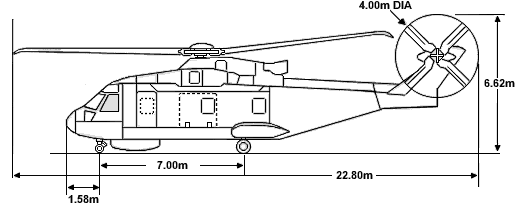

Sources and Resources
FAS |
Military |
DOD 101 |
Systems |
Aircraft |
ROW ||||
Index |
Search |
Join FAS
http://www.fas.org/man/dod-101/sys/ac/row/eh101.htm
Maintained by Robert Sherman
Originally created by John Pike
Updated Tuesday, September 21, 1999 10:18:15 AM

